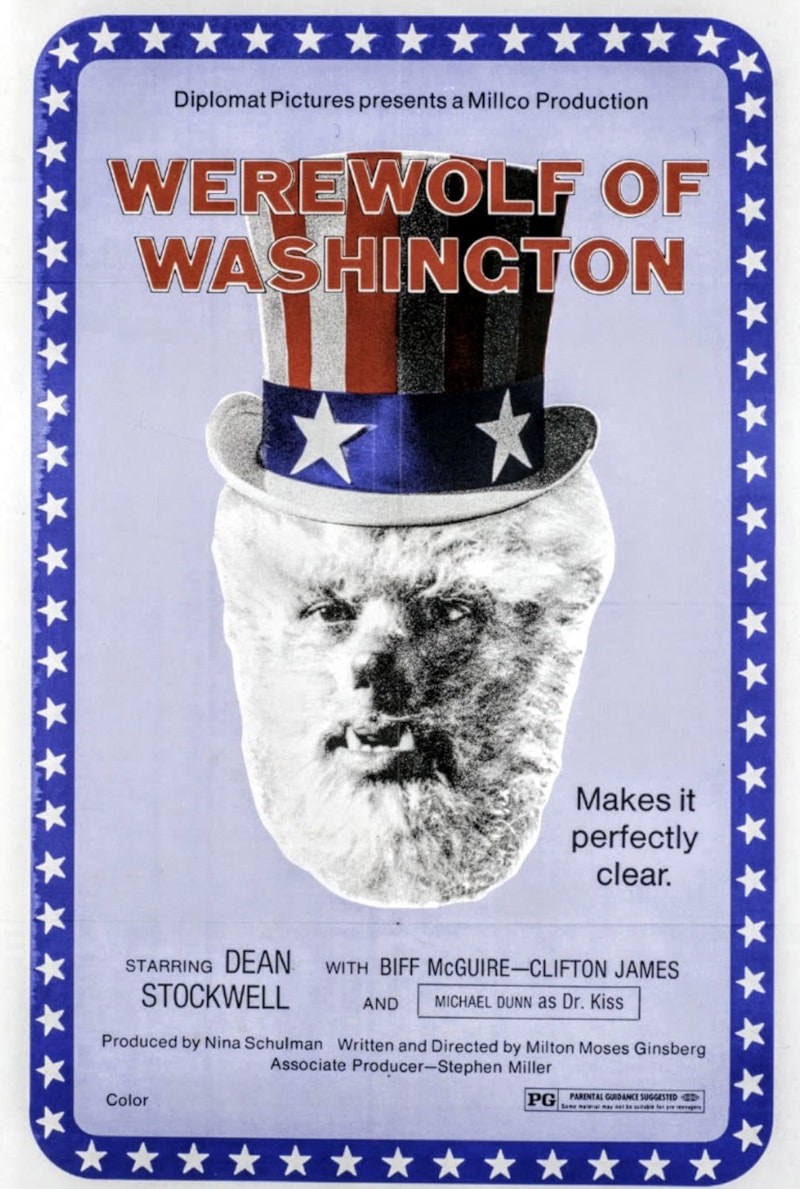Milton Moses Ginsberg was responsible for one of the strangest bad movies of 1973, a riotous schlockoid outburst called The Werewolf Of Washington. This slapstick horror film simmers with anti-Nixon symbolism, surreal underground film tropes, and an avalanche of shattered ambition. There are few meditations on Watergate-era politics that got more manic and eccentric than this. The film’s visual flare and the animated performance given by star Dean Stockwell make this a twisted period piece that’s as hard to summarize as the chaotic era it came from.
Four years before Werewolf’s release Ginsberg made a name for himself with Coming Apart, a sexually-charged experimental drama that starred Rip Torn and Sally Kirkland. Before that he’d been employed as an editor for NBC. Exactly how the director went from Coming Apart’s gritty burst of art-damaged tension to a satirical grade-Z werewolf movieis a mystery, but it had something to do with Israel Davis and Doris Wishman associate Andrew J. Kuehn. These two had produced Coming Apart and asked Ginsberg to try and work up some material inspired by the Watergate scandal. In a 2018 Washington Post article Ginsberg recalled that when he finally had a script to pitch the producers hated it. Monterey Pop editor Nina Schulman and fellow film newcomer Stephen Miller thought it had potential. They stepped in to serve as producers and the movie was shot over the course of four weeks in and around the Glen Cove, Long Island area (though DC’s infamous Watergate building and the Sans Souci restaurant both make cameos).
Despite its persistent goofiness, plot-wise The Werewolf Of Washington is straight forward. Stockwell plays Jack Whittier, a White House press secretary temporarily exiled to Hungary after having an affair with the president’s engaged daughter. While overseas he contracts lycanthropy after being attacked by a werewolf. Upon returning home, whenever the moon is full, he turns into a werewolf and starts killing the president’s political enemies. Scandal ensues as Whittier is driven insane while simultaneously attempting to hide his monstrous alter ego and shield the president from negative scrutiny.
With a small cast and few long shots, The Werewolf Of Washington benefits from a claustrophobic atmosphere that makes even the most ridiculous scenes feel like creepy found footage of hammy actors slowly going insane. It’s amazing how Ginsberg was unable to coax anything even vaguely resembling a realistic performance from the major players. Stockwell’s Jack Whittier is constantly one wacky facial expression away from being a stuttering blob of neurosis, while actress Jane House‘s turn as Marion—the president’s daughter—is absurdly one dimensional. The president (Biff McGuire) is a caricature of distraction and self-absorption. When he finally confronts the werewolf his ego-driven obnoxiousness is pushed to extremes resulting in the film’s biggest laughs.
Cinema verité elements, dark lighting, grainy film stock, and a loose script all create the kind of devil-may-care atmosphere that enlivened the early works of John Waters and Harry Novak. The movie bounces around between extremes of intentional and unintentional humor. It’s often impossible to tell exactly what Ginsberg was trying to pull off (the opening werewolf attack is the only overtly scary moment of the whole movie). More than anything else, The Werewolf Of Washington uses trashy aesthetics to mirror the seedy downfall of the Nixon administration. Jack Whittier serves more as a babysitter than a presidential staffer. For Whittier every move the president makes is a potential disaster. The real early-1970s White House Press secretary Ron Ziegler was dealing with many similar dramas on a daily basis at the same time.
Without a direct mention of Richard Nixon and his gang thiscan’t be called a counterculture artifact. Without a big budget the movie can’t be viewed as light escapism. Without a steady narrative or atmosphere it’s a little too weird to be pigeonholed as a horror movie. So where does that leave this cinematic mess? At its best, The Werewolf Of Washington stands as a confusing dispatch from a time when confusion was an ever-present part of America’s collective psyche.

